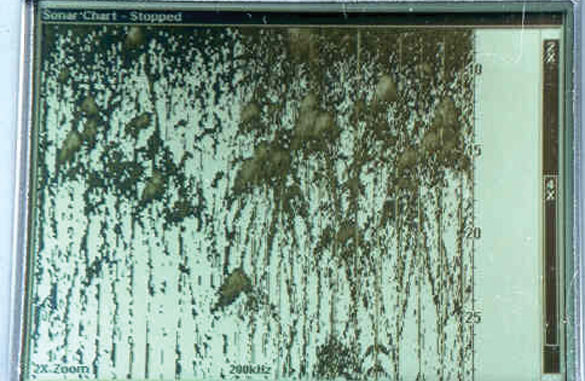
Poverty Point may be the hottest crappie lake in the state right now.
“When I turn on both my console and bow fish finders, at least one of them goes crazy!” This is the most common fish-finder complaint I hear, and it stems from a lack of understanding of how sonar works.
Symptoms can be as mild as vertical lines on one or both screens, or a diagonal pattern of lines that hides important details.
In more serious cases, multiple bottoms are displayed, and units sometimes jump from one range setting to another in confusion. Here’s what’s happening:
Sonar works by sending out a sound pulse, waiting to receive echoes back from it and then sending out another pulse. Units are programmed to “know” the speed of sound through water, and they determine the depth of objects by measuring the time it takes for sound to travel down to them and return.
Many pulses can be transmitted each second, but it’s important to remember that the unit has to wait for echoes from one pulse to return before transmitting the next pulse. If it didn’t wait, it wouldn’t know which pulse was responsible for which echo, and that would make its critical timing function impossible.
Turn on a second fish finder that operates on the same frequency in the same boat, and here comes that timing problem. Each unit thinks its last sound pulse is responsible for all the echoes it now receives from both units, and it performs its timing function accordingly. Confusion results.
It is impossible to place two transducers far enough apart on a boat to prevent interference; in fact, the second fish finder doesn’t even have to be in the same boat to cause trouble. I have seen lines on my screen from a sonar unit in a boat nearly a hundred feet away.
The problem is at its worst in crystal-clear water over a hard bottom, and is less severe in dirty water over a muck bottom. The more sensitive a unit is, the more susceptible it is to crosstalk.
Strangely enough, some fishermen run two units on the same boat at the same time and don’t experience crosstalk.
If the two units are pretty evenly matched in terms of output power and receiver sensitivity, a bit of automatic filtering can wipe the interference off their screens.
Unfortunately, it often takes such a high level of filtering that important details get erased with the interference. The screen image takes on a blocky look, and it becomes impossible to see smaller details like weeds and baitfish. The ping speed on some units can be adjusted, and slowing the ping rates can give two units time to send and receive echoes alternately.
The best way to prevent crosstalk is to turn one unit off, or choose a pair of fish finders with different operating frequencies.
In my experience, it takes a frequency difference of at least 30 kHz to prevent interference. You can’t, for instance, use an old Lowrance unit that operated at 192 kHz and a new Lowrance unit that operates at 200 kHz and expect them not to interfere with each other.
The most popular sonar frequency in fresh water is 200kHz. The most popular dual-frequency units designed for saltwater use 200 kHz and 50 kHz. These frequencies got popular by providing the best performance under the widest range of circumstances, and it’s difficult to find units with different frequencies.
Pinpoint sonar units can be networked with an optional In-Sync cable that causes both units to fire sound pulses at the same instant, and eliminates the timing problem. You can also sometimes mount two dual-frequency units on one boat and lock one on 200 kHz and the other on 50 kHz. This doesn’t always work because some dual-frequency units still use their other frequency for certain functions — you can’t completely lock the second frequency out.
Crosstalk interference has been around since bulb-type flashers were high tech, and it will probably stay with us until some sonar engineer’s brainstorm plots a course around it.


